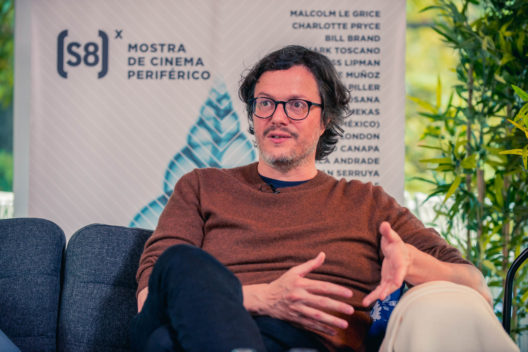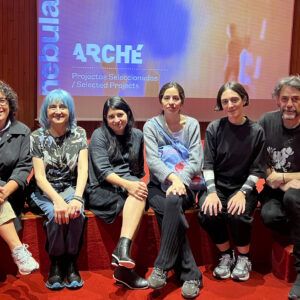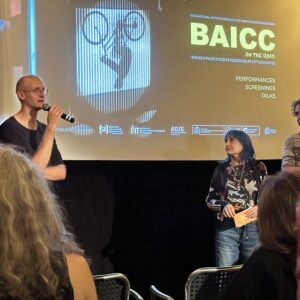
How did you get to specialize in experimental films?
I’ve been a film lover since I was pretty young. And most people that get very passionate about film usually start with the more obvious stuff, the classics, or the new exciting movies when you’re young, and that you’re excited to see. And, if you really develop this passion, you start looking for more marginal and unusual things, and at some point, I think in my late teens, I started to encounter, for example the films by Bruce Conner, of Kenneth Anger, Stan Brakhage… actually some VHS releases of their films –I had access to a video store that had pretty cool stuff, when I move to Berkeley to graduate. So I started to get into more unusual things, stuff that now isn’t maybe that crazy, things like Wings of Desire or films by David Lynch. In any case, stuff that doesn’t conform to the typical mainstream models of cinema that I grew up with. Also, I had the great fortune of taking a class with Kathy Geritz, who is a curator at the Pacific Film Archive, and this class was about avant-garde film. And this was a very amazing introduction to it, including some films that I hated, but still they stayed with me. For example a film by Ken Jacobs called Keaton’s Cops, and a film by Paul Sharits called T,O,U,C,H,I,N,G, but I was fascinated by them, too, and I didn’t forget them, so I started thinking about why I hated them. And eventually, of course, I came to love both of them. And soon after that I studied film archiving, it occurred to me that this was an interesting area where there’s not a lot of archival work being done. I mean, there are people doing it, including some of the other guests here, like Bill Brand, and Ross Lipman. But I didn’t necessarily study film archiving looking to work on experimental film, but those were two interests that I had. And when I came back to the San Francisco area after studying film archiving in NY, I got a job at Canyon Cinema, which is a big distributor of experimental work. I mean… it was big, but it was two people: the director, and me, so it wasn’t that big! It looked big to me, in reputation. I spent three years there, working very closely with the films, getting to know about their history, the films themselves, and also getting to know the artists. Those were three years of extremely concentrated education on experimental film, so when I was hired at the Academy in 2003, I’m pretty positive that one of the reasons was that they wanted to increase the amount of work that was being done on experimental film, and probably they saw me as someone who had an archival background, but also this connection with the avant-garde. So it started in a very organic way, not necessarily planned. But once I was hired by the Academy to provide this experimental work, it took me a few years to figure out how to really do it –what they expected from me and the resources the Academy had, how to use them best to get the results.
I gather that maybe in formal training for film archiving there’s not a lot of space given to experimental cinema. Did you need to invent ways to do it?
Yes, it’s true. Especially in 1999, when I studied archiving… there was some documentations, articles that people had written about restoring and archiving experimental film, people like Toni Treadway and Marylee B., who used to be at MoMA, and Ross… but it’s not like there’s a book you can get. And a lot of the work that I’ve come to do… Nobody had work with those filmmakers before. Like, weirdly, Stan Bakhage. I started working with his films 2004, and although some of his films were archived in anthologies before, it’d been done in different ways. Stan had not wanted to give his originals, at that time, so the anthologies were done with secondary materials. It was a useful archiving project, but weirdly, nobody had worked on Stan Brackhage’s originals before, which seems crazy. So I had learned about archiving and film preservation generally, and my colleagues at the Academy, that had been there longer, like my supervisor Joe Lindner, and the director of the archive, Mike Pogorzelski, he was originally a preservationist, and he restored Castro Street by Bruce Baillie… and both of them had studied film as grad students, with G. G. Murphy and so on, so they really have an appreciation for film, including experimental film. And through them, I was also exposed to the practices and the practicalities of preservation, and as soon as I started to look on experimental films, I realised that most of the times these typical rules didn’t apply. So in general, I was making up my approach, but really in response to what I was discovering. Like, for example, over a few years I would start to notice… OK, I have this stock from the mid-70s, I know this behaves in a certain way, and so I can kind of predict what we need to do… or just different technical approaches that filmmakers do, that were very common back then, but people don’t use them anymore. So I was able to figure out why there was a magnetic soundtrack for a film, but not an optical one, etc., and there are reasons for that, it’s not just crazy behaviour. So for me it was a combination of looking at the literature produce by my colleagues, and the things that I was figuring out by myself, especially thanks to having worked at Canyon Cinema in a very empiric way, because of all the things that I had to do by myself –you really start to learn and figure out things from doing it so much, during 16 years! It’s kind of crazy.
What about the selection of works that you’ve chosen to present here at the (S8)?
Well, two of the films had a particular problem in common. There’s a particular film stock that I hate, one that Kodak made from 70-71 until the mid-80s, and that’s called Ektachrome Commercial. Before that there was another Ektachrome Commercial, which wasn’t bad for archival stability, but the one they made from the 70s onwards was quite bad: the colour fades really badly, and unfortunately that was a very common film, that was used especially by animators and people in optical printing, but also people who were shooting in daylight. It depended on what kind of filmmaking they were doing, but some features, like The Texas Chainsaw Massacre, was shot on this stock, actually. And it fades pretty reliably and it’s quite hard to correct without digital tools, but if it’s not too faded you can deal with it with analogue colour grading, and I worked on some films where we were able to get a very good result doing it that way. However, usually the colour has to be digitally restored. That was the case with Saugus Series by Pat O’Neill and Chicago Loop by James Benning. In the case of James Benning’s film, we agreed to restore it –because usually those films are restored by the Austrian Film Museum, which have been doing an amazing work– and when the materials came, I knew the colour would be faded. And this involves scanning the film and colour-correcting it digitally. Locally, James was in L.A., so he could just come, and we would look at it together, and work on the colour… He could actually oversee it, which was really good. It was a pretty straightforward process, but… it was expensive, and then we had to put it back on film. Pat O’Neill’s film was more complicated, also because the first section of the film was damaged, so we couldn’t use the original for the first section. Luckily, in 1974 Pat had also made an intern negative for the film, so for the restoration we took part of the film from this other negative. Then it was about piecing it together digitally, and fixing the colour, and Pat coming in, again, because he’s in L.A, too, and it’s quite convenient, and working on the sound… I mean, these are some anecdotes to say that every project is unique, even though there might be common problems to them.





